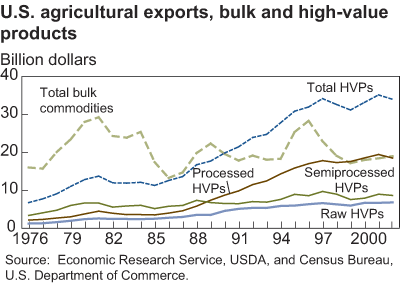Processed Products Propel Gains in U.S. Agricultural Exports
- by Carol Whitton
- 4/1/2004
Processed high-value products (HVPs) accounted for most of the growth in U.S. agricultural exports between 1976 and 2002, with $11 billion of the $30-billion total gain in U.S. agricultural exports during that period. In 2000 and 2001, exports of processed HVPs alone (meats; canned, dried, and frozen fruits and vegetables; processed grain products; dairy products; essential oils; juice; and wine) surpassed bulk agricultural exports to become the largest category of U.S. agricultural exports. Most of the growth in processed HVP export value occurred in the 1990s, the result of the depreciation of the dollar (between 1986 and 1996) and trade agreements, such as the North American Free Trade Agreement (NAFTA).
Exports of raw HVPs—fresh fruits and vegetables, live animals, nuts, and nursery products—also expanded over the 26-year period and have shown strong growth since 1989. These benefited greatly from NAFTA because of the high cost of special handling needed to preserve freshness. Shipping by truck to neighboring countries is far less costly than air freight to more distant destinations. Exports of raw HVPs rose 5.1 percent annually between 1989 and 2002. In 2002, as a result of growth in exports of U.S. raw HVPs to Canada and Mexico, U.S. agricultural exports to the Americas exceeded those to Asia for the first time in history. Canada surpassed Japan as the largest single market for U.S. agricultural exports, with Mexico ranked third.
The third subgroup of HVPs, semiprocessed HVPs, includes feeds, hides, fats, fibers, and oilseed products. Semiprocessed HVPs showed much less growth in exports, averaging only 2 percent yearly from 1989 to 2002.
U.S. exports of bulk commodities—wheat, rice, coarse grains, oilseeds, cotton, and tobacco—formerly the largest category of U.S. agricultural exports, were overtaken by HVPs in 1991. Bulk exports were $3 billion lower in 2002 than in 1989, and between 1976 and 2002, their share of total U.S. agricultural exports plummeted from 70 to 30 percent. Bulk exports are more variable than HVPs, depending on global supplies, global income growth and consumer demand, prices, and relative exchange rates. Gains in bulk exports were dampened, particularly in the 1990s, by the protectionist policies of the European Union, reduced demand from the former Soviet bloc countries as they became more market oriented, and increased export competition from these countries, as well as Argentina, Brazil, and China.
Although corn, soybeans, and wheat—all bulk commodities—are still the largest U.S. agricultural exports in value, fresh beef has been the fastest growing export. In 2002, beef ranked fourth among individual product exports.
This article is drawn from:
- Foreign Agricultural Trade of the United States (FATUS). (n.d.). U.S. Department of Agriculture, Economic Research Service.
- U.S. Agricultural Trade. (n.d.). U.S. Department of Agriculture, Economic Research Service.
- Whitton, C. (2004). Processed Agricultural Exports Led Gains in U.S. Agricultural Exports Between 1976 and 2002. U.S. Department of Agriculture, Economic Research Service. FAU-85-01.


